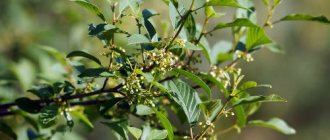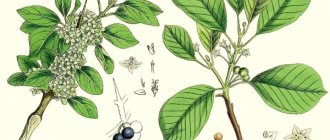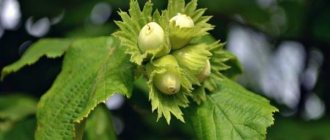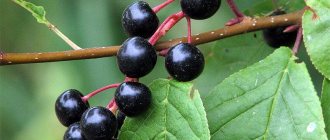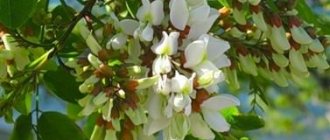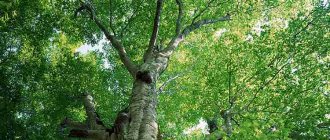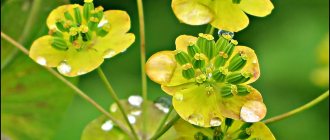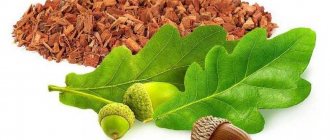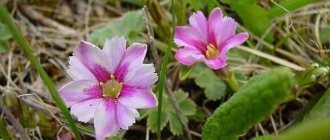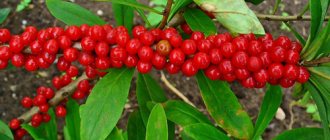1 Health 05/08/2018
Dear readers, among the plants that surround us, there are many that we are so accustomed to that we don’t even always notice them. However, they all have beneficial properties that can be used to your advantage in case of certain diseases and health problems. Today we will talk about one of them - buckthorn, common in our latitudes. We will look at its medicinal properties and contraindications, and also talk about how to use buckthorn bark.
Where does buckthorn grow and what does it look like?
Buckthorn can be a shrub or a small tree. It grows on forest edges, near ponds and is often found in the city. There are more than 150 species of buckthorn and are common in Europe, Asia and North America.
This tree-like shrub has a smooth trunk and shiny leaves of a rich green color. Buckthorn can reach seven meters in height. Buckthorn blooms in May-June with small yellowish flowers, the berries turn from green to red and turn black by the end of summer.
We most often find brittle buckthorn (it is called alder buckthorn) and zhoster (laxative buckthorn). Zhoster has dark bark and has spines on its branches. Let's see what buckthorn looks like in the photo.
Composition of buckthorn
Buckthorn has a specific composition; its bark is used in medicine, including folk medicine. The plant contains:
- tannins;
- alkaloids;
- succinic, malic acid;
- vitamin C;
- minerals – potassium, calcium, iron, manganese, copper, magnesium;
- essential oils (mainly found in berries);
- sugars (gum, pectins);
- resins;
- flavonoids;
- saponins;
- anthraquinones, which have an emetic effect.
Fragularoside in buckthorn causes nausea and vomiting - it is toxic. After a year of storing raw materials, it ferments and becomes safe. Therefore, freshly harvested buckthorn bark is dangerous; it must be kept for at least a year.
To speed up the fermentation process of buckthorn bark, it is intensively dried in the oven at a temperature of 100˚C for at least an hour. This accelerates the breakdown of toxic compounds. However, it is safest to buy buckthorn bark in a pharmacy in the form of a ready-made collection.
Brittle buckthorn - beneficial medicinal properties and uses
In general, both brittle buckthorn and laxative buckthorn are well-known laxatives, as can be seen from the name of the latter. Brittle buckthorn bark has a bitter taste and a faint odor. Its berries have a diuretic effect and are used to prepare pharmaceuticals. They are less commonly used for swelling, constipation, diarrhea, and menstrual bleeding. Buckthorn berries are taken dried, after 2-3 years of storage, on the recommendation of a doctor.
Indications for use
Brittle buckthorn bark and preparations containing it are used as a laxative for a number of diseases:
- constipation;
- haemorrhoids;
- worms;
- stomach and duodenal ulcers, gastritis, colitis;
- liver diseases;
- pain in the stomach and intestines;
- menopause;
- radiculitis, rheumatism;
- fever;
- skin inflammation, eczema, scabies, streptoderma, furunculosis;
- diabetes;
- obesity;
- diseases of the nervous system.
Brittle buckthorn is not just a laxative - the tannins in its composition normalize intestinal function.
In gynecology, buckthorn is used to induce menstruation. On the recommendation of the gynecologist, use a decoction - 2 tbsp. l. crushed bark per glass of boiling water. Prepare the decoction in a water bath for half an hour, cool, filter and take half a glass before bed. Sometimes buckthorn is combined with lemon balm and valerian root.
You cannot combine buckthorn with other laxatives.
Take alder buckthorn for no more than 8 days. It is important that the doctor selects the dosage individually.
Composition and medicinal properties of zhoster
- The plant contains a large number of useful substances. In particular, these are anthraglycosides, various tannins, and flavonoids.
- Also, buckthorn contains ascorbic acid, bitterness, sugar, gum, various organic acids and dyes.
- Zhoster laxative got its name for a reason. This plant is primarily used as a laxative.
- In addition, buckthorn is used for complete loss of stomach tone and for spastic colic.
- Zhoster is widely used to regulate intestinal activity; it is an excellent remedy for hemorrhoids and cracks in the colon.
Article on the topic: Arctic princess - useful properties, description
Buckthorn laxative - medicinal properties and uses
Buckthorn laxative, or zhoster, is more often used for the manufacture of medicines. Its bark and fruits have a not very pleasant smell and taste bitter-sweet. The bark of this type of buckthorn turns black after drying.
The scope of application of laxative buckthorn is also quite wide:
- digestive problems, lack of appetite, constipation, hemorrhoids;
- hepatitis;
- intestinal atony;
- stomach ulcer;
- helminthic infestation;
- gout, rheumatism;
- fever;
- anemia;
- skin rash, ringworm, furunculosis;
- swelling due to kidney problems;
- headaches, depression;
- menopause;
- respiratory infections;
- Graves' disease.
Lotions and compresses with buckthorn decoction are used to heal wounds. The seeds of this type of buckthorn recently began to be used in the treatment of leukemia.
Unripe laxative buckthorn berries are poisonous and contain toxins (hydrocyanic acid is present in the seeds). Ripe fruits can be eaten no more than 10-12 pieces before meals, but it is better to be careful with these berries and purchase a prepared mixture at the pharmacy.
Application of zhoster in medicine
In folk medicine, a decoction of joster is used for stomach ulcers; externally in the form of compresses - wound healing.
Branches, leaves, fruits. In folk medicine, a decoction is used for hypoacid gastritis and dermatomycosis.
Fruit. Decoction, infusion - laxative. They are included in laxative teas and complex mixtures for the treatment of chronic, atonic and spastic constipation, and rectal fissures.
In medical practice - for intestinal motility disorders in women during menopause.
Essence - in homeopathy.
In folk medicine - for ascites, gout, chronic skin diseases, gastritis, intestinal atony, hemorrhoids, hepatitis, respiratory infections. Used for dermatomycosis and as an anticancer agent.
Article on the topic: Thyme-flowered snakehead - beneficial properties, description
Alcohol solution - for rheumatism.
The juice is a potent laxative and diuretic; for dermatitis.
Medicinal properties of buckthorn bark
In addition to its laxative and digestive-regulating effects, there are other medicinal properties of buckthorn bark provided by the substances it contains.
- Tannins give it bactericidal properties. They allow you to eliminate staphylococcus, dysentery bacillus, etc. Tannins also remove heavy metals;
- alkaloids – give an analgesic effect, have a sedative and hemostatic effect;
- anthraglycosides are compounds in buckthorn that, in addition to a laxative effect, have a beneficial effect on gallstones, kidney stones, gout and skin diseases;
- organic acids (succinic and malic) are natural antioxidants that help cleanse the body of toxins and waste. They are also beneficial for blood vessels, digestion, and calm the nerves;
- gum - allows you to remove toxins from the body and lowers cholesterol levels;
- pectins – also lower cholesterol and remove toxins, normalize metabolism, and improve blood circulation;
- ascorbic acid (vitamin C) is a non-enzymatic antioxidant. It is useful for the endocrine system and central nervous system, for hematopoiesis;
- essential oils – have antiseptic, anti-inflammatory, bactericidal effects. Calm the nervous system;
- ash components – provide disinfection and healing of wounds, help dissolve blood clots;
- resins – also have an antibacterial effect and strengthen the immune system;
- flavonoids are beneficial for blood vessels, inhibit the aging process, have an antitumor effect and exhibit antioxidant properties;
- saponins – have a diuretic and anti-sclerotic effect, are useful for peptic ulcers, coughs, and tone the body.
Due to its good mineral composition, buckthorn also has antiviral, astringent, antispasmodic, and anticancer effects.
Medicinal properties of buckthorn - indications for use
What are the benefits of buckthorn bark for the body?
Buckthorn decoctions and infusions are primarily prescribed to patients who often experience intestinal dysfunction, which manifests itself in the form of constipation. But this is not the only area of application for buckthorn bark; it is also used in the following cases:
1. For liver diseases, decoctions and infusions of buckthorn are taken to cleanse it. 2. Therapy for hemorrhoids. Tinctures and decoctions help reduce pain and the size of the inflamed hemorrhoid. Due to their laxative effect, they help prevent injury to the hemorrhoid and make it impossible for bleeding to develop. 3. Has an anti-edematous effect. 4. Used in the treatment of gout. Reduce pain. 5. For skin pathologies, decoctions are applied locally, in the form of lotions or applications. They help relieve itching, irritation, reduce swelling and redness. 6. Buckthorn bark has a positive effect on the female body during menopause. 7. Due to the fact that this medicine has a strong cleansing effect, it can be used by patients who want to lose excess weight. This explains the renewed widespread use of buckthorn bark for weight loss . 8. For diabetes mellitus, a folk remedy can normalize blood sugar levels. 9. The bark can also be used to relieve excess gastric juice or to maintain bile production in the body. 10. Can be used as an anthelmintic to combat intestinal parasites.
And this is not all the benefits of buckthorn for the body...
Currently, buckthorn bark is often used in cosmetology. Its ability to rejuvenate the skin, relieve it of acne, blackheads and boils is noted. For this purpose, decoctions are used to wash the face.
Ways to use buckthorn bark
Now let's look at how you can use the bark of this plant for health and beauty.
Buckthorn bark for weight loss
When used, the intestines are cleansed, which means weight loss. Buckthorn bark prevents the absorption of fluid from the intestinal mucosa. The plant does not irritate the mucous membranes; it can be used for various diseases of the stomach and intestines. The bark also normalizes metabolism, which is important when losing excess weight.
When losing weight, buckthorn is used both separately and in combination with other herbs. You can use this recipe for weight loss with buckthorn: pour a teaspoon of bark into 200 ml of boiling water. Keep in a water bath for half an hour. The decoction is infused for 40 minutes, filtered and taken in the evenings. Dosage – 150 ml. The course lasts 1-4 weeks.
For weight loss, buckthorn bark is taken with yarrow, rowan, nettle, licorice root and eleutherococcus.
With long-term use of buckthorn, the body develops a habit, as a result of which weight stops losing. Therefore, it may be necessary to increase the dosage, but this is fraught with colic and stomach pain. In this case, buckthorn should be abandoned and other methods and means should be used.
Buckthorn bark for constipation
Buckthorn gives a mild laxative effect, which manifests itself 8-10 hours after ingestion.
A decoction of buckthorn bark for constipation is prepared as follows: pour 20 g of bark into an enamel bowl with 1 cup of boiling water. Boil the mixture in a water bath for 30 minutes, then quickly cool it with cold water in the sink. The broth is filtered and brought to the original volume by adding boiled water. Drink 100 ml before bedtime.
They also make an infusion of buckthorn bark and herbs. Take bark - 10 g, cumin - 5 g, centaury - 5 g and chamomile - 5 g. Two teaspoons of the mixture are poured into 250 ml of cold water. Leave for 12 hours and filter. You need to drink it warm in a dosage of 1 cup on an empty stomach before bed.
Buckthorn bark in cosmetology
Buckthorn in the form of a decoction will relieve skin inflammation, eliminate acne, and heal minor wounds. A decoction of the bark has a rejuvenating effect on the skin.
It can also be used as a natural hair dye. Brittle buckthorn will color your hair brownish-red or dark yellow. The shade will depend on the initial hair color. To obtain the desired shade, several stains are done. Buckthorn also gives hair a golden shine, stimulates growth and restores hair structure.
For coloring 1 tbsp. l. crushed bark, pour a glass of boiling water and cook over medium heat for 10 minutes. Cool and filter, apply to hair and wrap for 30-50 minutes, then wash your hair.
Buckthorn for children
For children, buckthorn bark is also used as a laxative. It is recommended to buy the pharmaceutical drug in syrup form. When taking the syrup, your urine may turn bright yellow due to the presence of chrysophanic acid in buckthorn, but this is not dangerous. If the child develops a rash or abdominal pain, stop taking it.
Zhoster laxative in recipes of traditional healers
Medicines from joster - infusions, decoctions, tinctures, extracts - have been taken to treat various diseases since ancient times. Adherents of unconventional methods of treatment use drugs from this plant to treat constipation, hemorrhoids, rheumatism, and gout. The plant has wound healing and antibacterial effects. The fruits and bark of joster are used as a natural dye for wool and cotton silk.
The plant is popularly called lady berry, needle buckthorn, needle buckthorn, blackberry, witch's thorns. Zhoster is valued by cosmetologists. Remedies from the plant are used to treat skin ailments.
Botanical characteristics
Zhoster is a highly branched shrub or small tree belonging to the genus Zhoster and the Buckthorn family, reaching a height of seven meters or more. Zhoster is equipped with shiny reddish-brown or yellowish-gray bark, opposite simple rounded ovoid finely serrated pointed pubescent leaves, small unisexual green flowers collected in axillary inflorescences.
Zoster blooms at the end of the spring period, and the fruits - juicy, bitter, six-millimeter drupes - ripen at the end of the summer period. The European territory of Russia, the Caucasus, Siberia, Central Asia is the habitat of the zoster. Open areas, thickets of bushes, undergrowth are places of growth.
Collection and preparation
The medicinal raw materials for the preparation of preparations are the fruits of joster. It is recommended to collect raw materials during the period of full ripeness - in early autumn. Ripe fruits are black in color. After collection, they must be dried. You can spread the berries on paper and dry them outside in the shade, or you can use a special dryer to speed up the process. The temperature in the dryer should not exceed fifty degrees. Properly dried fruits should crumble when pressed.
Harvested fruits are placed in bags or boxes and stored in a dry place with adequate ventilation. The blanks can be stored and used for four years.
Composition and healing power
The widespread use of zhoster is due to its rich composition. Zhostere contains many useful, nutritious and healing substances:
- ascorbic acid;
- macro- and microelements;
- alkaloids;
- essential oils;
- organic acids: succinic, malic;
- pectin;
- gum;
- saponins;
- tannins;
- bioflavonoids;
- atraglycosides.
The following healing properties of the plant are known:
- immunomodulatory;
- antiulcer;
- cardioprotective;
- anti-inflammatory;
- radioprotective;
- laxatives;
- antimicrobial;
- general strengthening;
- antiviral;
- antioxidant;
- antioxidant;
- capillary stabilizing.
Article on the topic: Kupena fragrant (fragrant) - beneficial properties, description
Zhostere products contribute to:
- neutralization of free radicals;
- strengthening the immune system;
- elimination of inflammatory processes;
- cleansing the intestines;
- lowering the level of harmful cholesterol in the blood;
- normalization of intestinal microflora;
- appetite suppression;
- normalization of metabolism;
- improving the condition of the dermis, hair and nail plates;
- improving the general condition of the body;
- therapy: obesity, menopause, wounds, rheumatism, hepatitis, ascites, constipation, intestinal atony, hemorrhoids, gout, skin pathologies, respiratory ailments, colitis, diarrhea, gastritis, cough, heart failure.
Folk recipes
There are a huge number of medications available to treat a wide variety of diseases and conditions. Zhoster is certainly an effective and healing plant. However, inappropriate use of products from the plant is fraught with serious consequences.
That is why you should not abuse medicines from plants, or exceed the recommended doses and proportions. Any treatment should be in moderation. In addition, do not forget to consult your doctor before starting to treat a particular ailment.
Preparation of a drug with a laxative effect
Squeeze the juice from the fresh fruits of the plant and combine seventy milliliters with sugar - thirty grams. Place the container on the stove and wait until it boils. As soon as the sugar has dissolved, the syrup can be poured into a container convenient for storage. This remedy is given to children suffering from constipation. Dosage – a spoonful of the composition per day.
Constipation: infusion therapy
Steam twenty grams of dried crushed joster fruits in two hundred milliliters of just boiled water. Place the container in a warm place for two hours. Drink ½ glass of filtered drink before going to bed.
Arthritis, rheumatism, radiculitis: use of tincture
Pour one hundred grams of dry crushed fruits of the plant into a glass container. Fill the raw materials with vodka - half a liter. Leave the tightly closed bottle in a cool place for two weeks. Use the tincture to rub on painful areas.
Making relaxing tea
Mix equal amounts of joster bark and berries with hay leaves, licorice and anise. All components must be pre-dried and crushed. Brew two tablespoons of raw material in boiled water - 200 ml. The composition should be infused for half an hour. Take two spoons of filtered preparation three times a day.
Preparation of a strengthening decoction
Combine joster berries and chamomile in equal proportions. Brew two tablespoons of raw material in three hundred milliliters of boiling water. Place the container on the stove and wait until it boils. Boil the mixture over low heat for fifteen minutes. Take 100 ml of strained drink twice a day.
Hemorrhoids: treatment with infusion
Combine joster bark with crushed dill seeds and flaxseeds. Brew the raw material in a glass of boiled water. Place the mixture in a warm place for an hour. Divide the volume into two servings and consume throughout the day.
How to collect and store buckthorn bark
In pharmacies you can buy buckthorn bark in a variety of forms - filter bags, tablets, syrups. But you can also prepare raw materials yourself.
When to collect buckthorn bark
Early spring (March - early April) is suitable for collecting bark. The plant may already have buds, but there should be no foliage. If you scrape the trunk of an alder buckthorn, it will be red, not green.
Young branches or a trunk are selected; if there is lichen, it is removed. Several circular cuts are made. The distance between the transverse cuts should be approximately 15 cm. Then the ring cuts are connected with longitudinal cuts to remove the bark in the form of grooves.
How to dry buckthorn bark
Dry the raw materials under a canopy or in a ventilated area, covering them with cloth or paper. Lay out the bark in a layer of approximately 5 cm. During drying, the bark needs to be stirred occasionally. Completely blackened pieces must be removed. Drying may take several months. The bark is ready if it cracks and breaks when bent. Store raw materials for up to 5 years in a dry place.
Buckthorn - what is it, photo and description, types of buckthorn
Buckthorn is a perennial plant. It grows on the banks of rivers and lakes in forests. It looks like a small shrub, up to 3 meters high, but can sometimes grow in the form of a small tree.
It received the popular name “wolf berry” due to the fact that its fruits are poisonous. Eating 10 berries can cause serious poisoning, and in some cases even death of the patient.
At the moment, scientists know more than 150 varieties of this plant. But in medical practice three types are used.
1. Brittle or alder buckthorn. 2. Zhoster laxative. 3. American buckthorn.
For treatment, only buckthorn bark (its fruits are used in rare cases, and only topically), which is collected in the spring, when the buds swell.
Only young shoots are suitable for harvesting bark. Once the bark is collected, it is carefully tapped and sent to storage, where it is stored for a year before being used.
Recipes for decoction and infusion with buckthorn
Decoctions and infusions are prepared with buckthorn bark, and an alcohol tincture is also made for rubbing.
Decoction
For the decoction you need to take 20 g of bark in 2 cups of cold water. Cook on low heat for half an hour. Cool, take 1 tbsp. l. before bedtime. The laxative effect appears the next morning.
Infusion
For infusion, take 10 g of bark and 2 glasses of water. Insist for 10 hours. It is also possible to boil the infusion for 5 minutes and leave for 2 hours. Drink half a glass three times a day.
Tincture
Alcohol tincture is used for rubbing against gout and skin diseases. The bark and 40% alcohol are taken in a 1:1 ratio, left for 10 days, and filtered.
From this video you will learn about the composition of buckthorn, its medicinal properties, uses, contraindications and how to harvest the bark.
The use of zhoster laxative in folk medicine
Buckthorn decoction for constipation
You need to take 2 tablespoons of joster fruits and pour 800 g of them. boiling water Leave for 2 hours. After this, the broth must be filtered. Take 1 tablespoon 3 times a day. Experts recommend taking the product in the morning on an empty stomach.
Buckthorn tea for constipation
Take 20 gr. joster fruits and 20 gr. joster bark, 30 gr. senna leaves. Add 10 g to this mixture. licorice root and the same amount of anise fruit. Mix everything and take 1 tablespoon of this mixture. Pour this amount into 1 cup of boiling water. Leave for 20 minutes without stirring or stirring. After steeping, the tea must be strained. Take 100 ml of tea before bed.
Buckthorn decoction for constipation for children
You should take the fruits of joster in the amount of 10 grams. and pour a glass of boiling water over them. Place the broth on low heat and boil for 15 minutes. After that. Remove from heat and leave for another 20 minutes. After this, strain the broth.
Joster syrup for constipation in children
Take 30 g. 70 grams of joster fruits are added to them. Sahara. Place on fire and bring to a boil. Once the sugar has dissolved, the syrup is ready. Pour it into small containers. When constipation occurs in a child, give 2-3 teaspoons of syrup per day.
Tincture of joster fruits
The tincture is made with 70% alcohol or vodka. The tincture ingredients are taken in a ratio of 1:5. It is necessary to insist for 10 days in a dark, cool place. Take tincture 40 drops at night.
